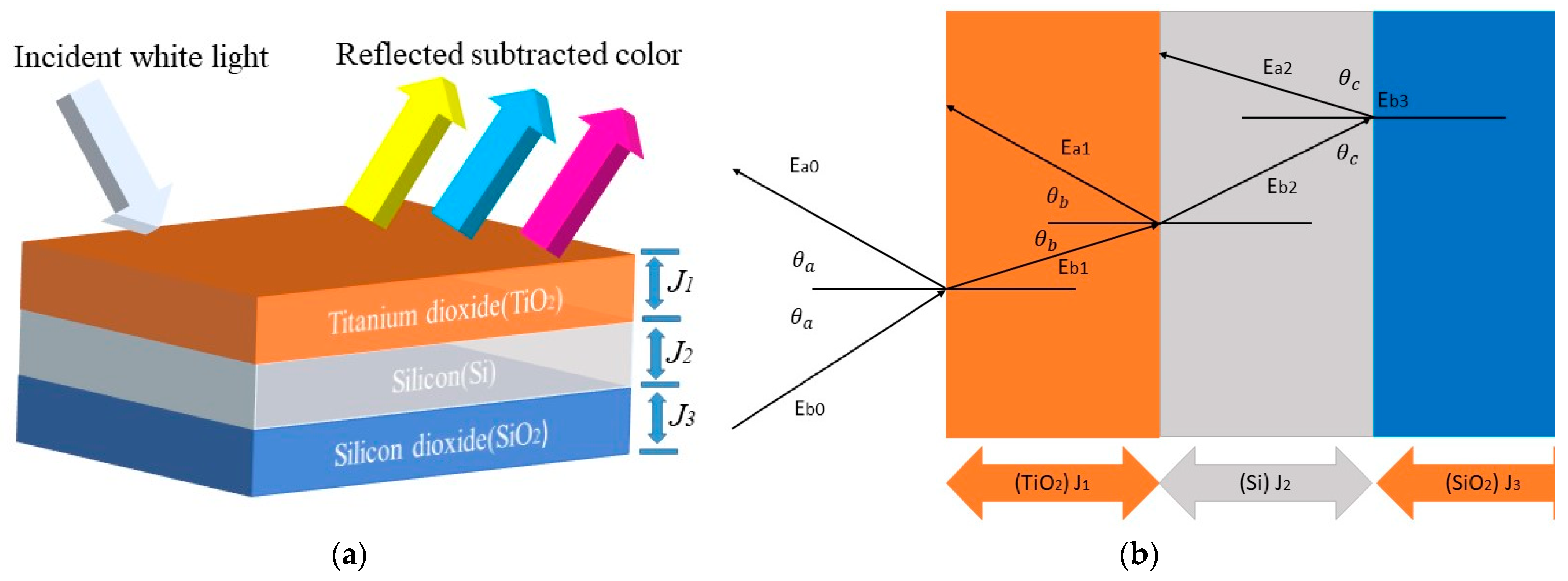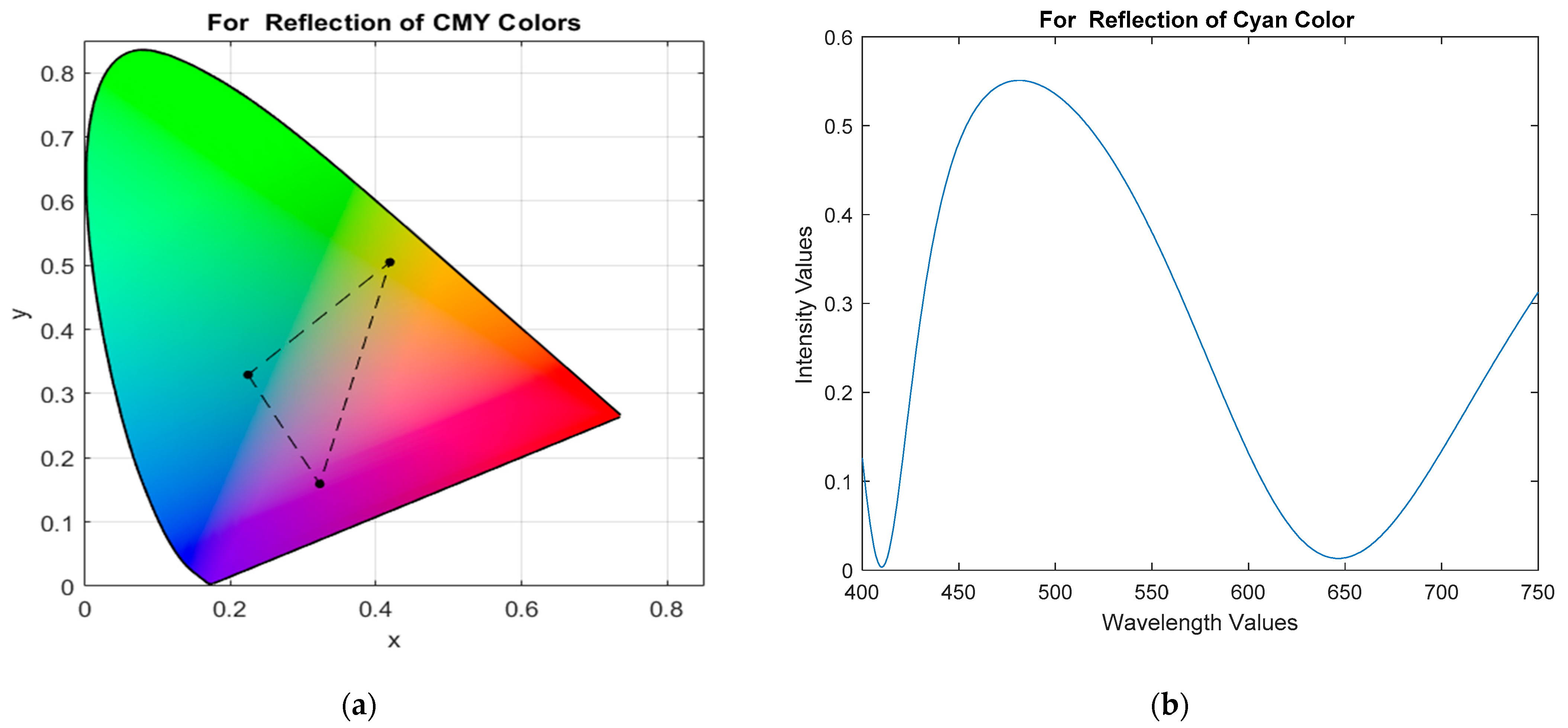An Efficient Opto Electronic Filter Design of Reflective CMY Colors for Optical Communications †
Abstract
:1. Introduction
2. Methodology
3. Simulation Results and Discussion
4. Conclusions
Author Contributions
Funding
Institutional Review Board Statement
Informed Consent Statement
Data Availability Statement
Conflicts of Interest
References
- Idachaba, F.; Ike, D.U.; Hope, O. Future Trends in Fiber Optics Communication. In Proceedings of the World Congress on Engineering 2014, London, UK, 2–4 July 2014; pp. 438–442. [Google Scholar]
- Jansen, S.L.; van den Borne, D.; Spinnler, B.; Calabro, S.; Suche, H.; Krummrich, P.; Sohler, W.; Khoe, G.-D.; de Waardt, H. Optical phase conjugation for ultra long-haul phase-shift-keyed transmission. J. Light. Technol. 2006, 24, 54–64. [Google Scholar] [CrossRef]
- Oliveira, J.; Magalhães, E.; Januário, J.; Siqueira, M.; Scaraficci, R.; Salvador, M.; Mariote, L.; Guerrero, N.; Carvalho, L.; Hooft, F.V.; et al. Toward Terabit Autonomic Optical Networks Based on a Software Defined Adaptive/Cognitive Approach [Invited]. J. Opt. Commun. Netw. 2015, 7, A421–A431. [Google Scholar] [CrossRef]
- Munguía, J.; Ciurana, J.; Riba, C. Neural-network-based model for build-time estimation in selective laser sintering. Proc. Inst. Mech. Eng. Part B J. Eng. Manuf. 2009, 223, 995–1003. [Google Scholar] [CrossRef]
- Gu, R.; Yang, Z.; Ji, Y. Machine learning for intelligent optical networks: A comprehensive survey. J. Netw. Comput. Appl. 2020, 157, 102576. [Google Scholar] [CrossRef]
- Kim, I.; So, S.; Rana, A.S.; Mehmood, M.Q.; Rho, J. Thermally robust ring-shaped chromium perfect absorber of visible light. Nanophotonics 2018, 7, 1827–1833. [Google Scholar] [CrossRef]
- Rana, A.S.; Zubair, M.; Anwar, M.S.; Saleem, M.; Mehmood, M.Q. Engineering the absorption spectra of thin film multilayer absorbers for enhanced color purity in CMY color filters. Opt. Mater. Express 2020, 10, 268. [Google Scholar] [CrossRef]
- Rana, A.S.; Zubair, M.; Danner, A.; Mehmood, M.Q. Revisiting tantalum based nanostructures for efficient harvesting of solar radiation in STPV systems. Nano Energy 2021, 80, 105520. [Google Scholar] [CrossRef]
- Rana, A.S.; Nasir, M.; Khan, H.A. String level optimisation on grid-tied solar PV systems to reduce partial shading loss. IET Renew. Power Gener. 2018, 12, 143–148. [Google Scholar] [CrossRef]
- Koirala, I.; Lee, S.-S.; Choi, D.-Y. Highly transmissive subtractive color filters based on an all-dielectric meta surface incorporating TiO2 nanopillars. Opt. Express 2018, 26, 18320–18330. [Google Scholar] [CrossRef]
- Lee, K.-T.; Seo, S.; Guo, L.J. High-Color-Purity Subtractive Color Filters with a Wide Viewing Angle Based on Plasmonic Perfect Absorbers. Adv. Opt. Mater. 2015, 3, 347–352. [Google Scholar] [CrossRef]
- Sadatnajafi, C.; Balaur, E.; Abbey, B. Bimodal Plasmonic Color Filters Enable Direct Optical Imaging of Ion Implantation in Thin Films. Adv. Funct. Mater. 2022, 32, 2009419. [Google Scholar] [CrossRef]
- Rana, A.S.; Mehmood, M.Q.; Jeong, H.; Kim, I.; Rho, J. Tungsten-based Ultrathin Absorber for Visible Regime. Sci. Rep. 2018, 8, 2443. [Google Scholar] [CrossRef] [PubMed]
- Park, C.-S.; Shrestha, V.R.; Lee, S.-S.; Kim, E.-S.; Choi, D.-Y. Omnidirectional color filters capitalizing on a nano-resonator of Ag-TiO2-Ag integrated with a phase compensating dielectric overlay. Sci. Rep. 2015, 5, 8467. [Google Scholar] [CrossRef] [PubMed]
- Park, C.-S.; Shrestha, V.R.; Lee, S.-S.; Choi, D.-Y. Trans-Reflective Color Filters Based on a Phase Compensated Etalon Enabling Adjustable Color Saturation. Sci. Rep. 2016, 6, 25496. [Google Scholar] [CrossRef]
- Naeem, T.; Rana, A.S.; Zubair, M.; Tauqeer, T.; Mehmood, M.Q. Breaking planar symmetries by a single layered metasurface for realizing unique on-chip chiroptical effects. Opt. Mater. Express 2020, 10, 3342–3352. [Google Scholar] [CrossRef]
- Kim, J.; Rana, A.S.; Kim, Y.; Kim, I.; Badloe, T.; Zubair, M.; Mehmood, M.Q.; Rho, J. Chiroptical Meta surfaces: Principles, Classification, and Applications. Sensors 2021, 21, 4381. [Google Scholar] [CrossRef]
- Shrestha, V.R.; Lee, S.-S.; Kim, E.-S.; Choi, D.-Y. Polarization-tuned Dynamic Color Filters Incorporating a Dielectric-loaded Aluminum Nanowire Array. Sci. Rep. 2015, 5, 12450. [Google Scholar] [CrossRef]
- Li, Z.; Butun, S.; Aydin, K. Large-Area, Lithography-Free Super Absorbers and Color Filters at Visible Frequencies Using Ultrathin Metallic Films. ACS Photonics 2015, 2, 183–188. [Google Scholar] [CrossRef]
- Shrestha, V.R.; Lee, S.-S.; Kim, E.-S.; Choi, D.-Y. Aluminum Plasmonics Based Highly Transmissive Polarization-Independent Subtractive Color Filters Exploiting a Nanopatch Array. Nano Lett. 2014, 14, 6672–6678. [Google Scholar] [CrossRef]
- Cheng, F.; Gao, J.; Luk, T.S.; Yang, X. Structural color printing based on plasmonic meta surfaces of perfect light absorption. Sci. Rep. 2015, 5, 11045. [Google Scholar] [CrossRef]
- Kats, M.A.; Blanchard, R.; Genevet, P.; Capasso, F. Nanometre optical coatings based on strong interference effects in highly absorbing media. Nat. Mater. 2013, 12, 20–24. [Google Scholar] [CrossRef] [PubMed]
- Shrestha, V.R.; Lee, S.-S.; Kim, E.-S.; Choi, D.-Y. Non-iridescent Transmissive Structural Color Filter Featuring Highly Efficient Transmission and High Excitation Purity. Sci. Rep. 2014, 4, 4921. [Google Scholar] [CrossRef] [PubMed]
- Lin, J.; Luo, S.; Zuo, D.; Wang, X. Multilayer structure for highly transmissive angle-tolerant color filter. Opt. Commun. 2018, 427, 158–162. [Google Scholar] [CrossRef]
- Yang, C.; Shen, W.; Zhang, Y.; Peng, H.; Zhang, X.; Liu, X. Design and simulation of omnidirectional reflective color filters based on metal-dielectric-metal structure. Opt. Express 2014, 22, 11384–11391. [Google Scholar] [CrossRef] [PubMed]




| Materials Placement | Name | Refractive Index Value (mo) | Material Nature | Thickness Notation (nm) |
|---|---|---|---|---|
| 1st layer | Titanium dioxide | 2.6 | Dielectric | J1 |
| 2nd layer | Silicon | 3.9 | Semiconductor | J2 |
| 3rd layer | Titanium dioxide | 1.4 | Dielectric | J3 |
| Reflective Colors | x-Axis (Ex) | y-Axis (Ey) |
|---|---|---|
| Cyan | 0.224 | 0.328 |
| Yellow | 0.419 | 0.505 |
| Magenta | 0.320 | 0.154 |
| Materials | Layer Thickness (nm) for Magenta Color | Layer Thickness (nm) for Cyan Color | Layer Thickness (nm) for Yellow Color |
|---|---|---|---|
| Titanium dioxide (J1) | 42.6 | 42.8 | 147.1 |
| Silicon (J2) | 8.06 | 74.2 | 88.1 |
| Silicon dioxide (J3) | 119.3 | 22.5 | 49.4 |
| Reflective Colors | x-Axis (Fx) | y-Axis (Fy) |
|---|---|---|
| Cyan | 0.220 | 0.328 |
| Yellow | 0.412 | 0.485 |
| Magenta | 0.321 | 0.153 |
| Previous Works | Magenta Color (x,y) | Relative Distance (RD) | Proposed Tri-Layer Design (RD) Value (0.0014) | Cyan Color (x,y) | Relative Distance (RD) | Proposed Tri-Layer Design (RD) Value (0.004) | Yellow Color (x,y) | Relative Distance (RD) | Proposed Tri-Layer Design (RD) Value (0.021) |
|---|---|---|---|---|---|---|---|---|---|
| [21] Meta materials | (0.38,0.27) | 0.1399 | Improved | (0.26,0.36) | 0.0558 | Improved | (0.42,0.42) | 0.0759 | Improved |
| [19] Multi-layer | (0.21,0.54) | 0.2197 | Improved | ||||||
| [7] Multi-layer | (0.32,0.16) | 0.0116 | Improved | (0.22,0.27) | 0.0578 | Improved | (0.46,0.44) | 0.0758 | Improved |
| [25] Meta materials | (0.32,0.16) | 0.0116 | Improved | (0.22,0.27) | 0.0578 | Improved | (0.46,0.46) | 0.0758 | Improved |
Disclaimer/Publisher’s Note: The statements, opinions and data contained in all publications are solely those of the individual author(s) and contributor(s) and not of MDPI and/or the editor(s). MDPI and/or the editor(s) disclaim responsibility for any injury to people or property resulting from any ideas, methods, instructions or products referred to in the content. |
© 2023 by the authors. Licensee MDPI, Basel, Switzerland. This article is an open access article distributed under the terms and conditions of the Creative Commons Attribution (CC BY) license (https://creativecommons.org/licenses/by/4.0/).
Share and Cite
Manzoor, S.H.; Manzoor, S.; Diez, M.A.P. An Efficient Opto Electronic Filter Design of Reflective CMY Colors for Optical Communications. Eng. Proc. 2023, 32, 1. https://doi.org/10.3390/engproc2023032001
Manzoor SH, Manzoor S, Diez MAP. An Efficient Opto Electronic Filter Design of Reflective CMY Colors for Optical Communications. Engineering Proceedings. 2023; 32(1):1. https://doi.org/10.3390/engproc2023032001
Chicago/Turabian StyleManzoor, Shahram Hamza, Shahinza Manzoor, and Mary Antonette Perez Diez. 2023. "An Efficient Opto Electronic Filter Design of Reflective CMY Colors for Optical Communications" Engineering Proceedings 32, no. 1: 1. https://doi.org/10.3390/engproc2023032001
APA StyleManzoor, S. H., Manzoor, S., & Diez, M. A. P. (2023). An Efficient Opto Electronic Filter Design of Reflective CMY Colors for Optical Communications. Engineering Proceedings, 32(1), 1. https://doi.org/10.3390/engproc2023032001





